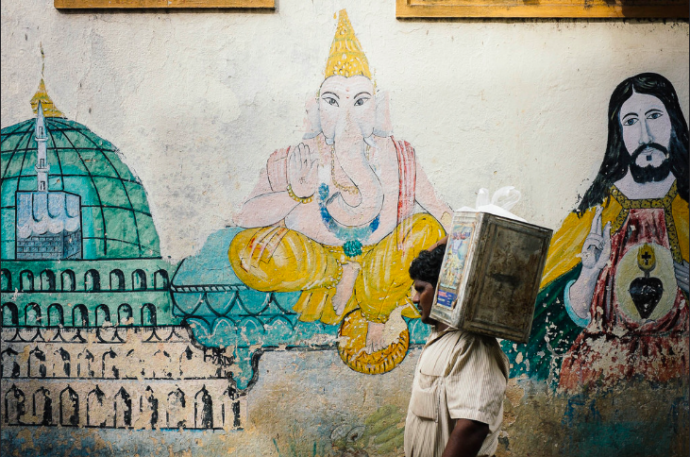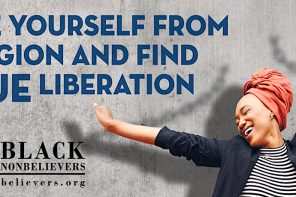Over the past few months, Indian and U.S. media have reported widely about right-wing Hindu groups’ plans to “re-convert” Muslim and Christians to Hinduism (and in some cases, Sikhism).
Indeed, the so-called ghar wapsi (“homecoming or conversion”) effort has rung alarm bells among observers, stoking fears that the right-of-center government of the Bharatiya Janata Party and Prime Minister Narendra Modi (a self-described Hindu nationalist), are seeking to undermine post-independence India’s secular ideals.
It has drawn so much attention, in fact, that it prompted President Obama to issue a not-so-subtle rebuke to Modi’s government for not doing more to protect religious minorities.
Among Indian Hindus—particularly the Hindu activist groups who embrace the conflation of Indian-ness with Hindu-ness—the fear of a disappearing tradition is stoked primarily by demographics. Indian census numbers show that the percentage of those identifying as Hindus dipped below 80 percent for the first time.
But while there is much talk about a rising Muslim population, the actual spikes have come among Christians, where the mass conversion of tribal groups and Dalits has been part of a sustained and systematic effort of “Great Commission” movements such as the Joshua Project.
The Christian population in India is now estimated at over 70 million: there has been unprecedented conversion over the last 10-15 years, on the heels of centuries of missionary efforts. In Nagaland, for instance, Baptists make up 90 percent of the population, and Christian separatist groups like the National Socialist Council of Nagaland have fought for a separate Christian state. We’re not talking about marginalized Indian populations finding Jesus, but rather a methodical and ethically ambiguous attempt at “harvesting souls”, which the Joshua Project and other missionary groups identify as part of their 10/40 window.
Moreover, Christian mission groups within India like Gospel for Asia and WorldVision are among the largest benefactors of aid, primarily from America.
While these missionary groups coerce peacefully, or simply just offer money from their well-funded coffers to get locals (usually village elders first) to convert, the predatory proselytization reflects what religion scholar Rita Sherma calls “spiritual violence,” a derivation of Johan Galtung’s concept of cultural violence. From a historical perspective, however, the centuries of religious violence in India—and the country’s unwillingness to truly acknowledge the history of that violence as a means of dialogue—has left an indelible mark on the country’s social fabric.
This is because religious conversion in India has been an ongoing, sublimated affair, often done behind closed doors and incentivized by free housing, education, food, clean water, and healthcare. Even during the Mughal era, violence was not the most common means of converting Hindus, Buddhists, and Jains to Islam. Instead, it was the jizya, the tax levied on non-Muslims, that over time won the most converts, and those conversions happened across caste lines.
The re-introduction of Christianity by the Portuguese to India’s west coast (where Syrian Christians had lived since the time of St. Thomas) in the 15th century did not come peacefully. The systematic destruction of Hindu, Jain, Buddhist, and even Muslim holy sites (and the erection of churches in their ruins) was a central component of the Goan Inquisition, a nearly two-century campaign sanctioned by the Catholic Church to convert non-believers—often violently—into Christianity. But the violence of the Portuguese era did not manage to “win hearts and minds.” British missionaries, schooled in the ways of catering to native populations, would have the most success in converting Indians through education and other incentives.
Over time, India’s social fabric incorporated Muslim and Christian norms, and ironically, many Hindu leaders embraced some of those norms in an attempt to re-interpret their religious scriptures from a modernist perspective. As a result, Hinduism itself became interpreted as more rigid and doctrinarian than its scriptural roots, and generations of Indians became Christianized (though not necessarily Christian) through India’s Christian parochial schools and a public education system shaped by Thomas Macaulay, whose stated aim was to create “a class of persons, Indian in blood and colour, but English in taste, in opinions, in morals, and in intellect.”
Thanks in large part to church-funded publications and university scholarship, Christianity also became part of the rhetoric of liberation among low caste populations and regional language groups such as Tamils.
This idea of Christianity “liberating” the uncivilized masses gained a following in the United States through the publication of the now comically racist Mother India by Katherine Mayo. From the late stages of British colonialism to modern times, the work of Christian mission organizations in India—and their adverse impact on local populations and ecosystems—has rarely come under scrutiny, save for an occasional piece in outlets like the New York Times.
Moreover, aggressive proselytizing by Christian groups has actually increased, including attempts at converting Hindu temple-goers right outside the temple doors.
To be sure, from a distance, it would appear that India’s religious minorities might suffocate from the weight of a nearly 80 percent Hindu population. But Hindu majoritarianism in India isn’t just a myth—it’s a practical impossibility because of the religion’s decentralized nature, extremely diverse and individualized practices, differences among various Hindu sects, and the geographical and political factors that have shaped the various interpretations of the religion across India and the subcontinent.
Perhaps more importantly, the vast majority of Hindus (and the vast majority of Indians) are not necessarily vested in religious identity politics, which usually manifest themselves most in the days and weeks ahead of local, state, or national elections.
Perhaps more problematically for progressives who critique the normative role of religion in societies, religious politics in India isn’t necessarily a left-right proposition. Hindu nationalist parties often mimic the socialist rhetoric of India’s left-of-center political establishment, while in states such as Karnataka, Kerala, West Bengal, and Tamil Nadu, political alliances between Marxists and religious minority parties (including ones funded by conservative Christian U.S. groups) are quite common. Even the BJP recently entered into a power-sharing alliance with a Muslim party in the Muslim-majority state of Jammu and Kashmir, underscoring how politics trumps religious affiliations.
As such, contrary to the caricature of U.S. media portrayals, there aren’t roving Hindu mobs roaming the streets of Indian cities or rural villages converting Muslims and Christians en masse. Moreover, the lines between religion and clan, caste, and regional identity are often much more fluid and ambiguous—and often contradictory. Religious conflicts are often intertwined with politics, and the frequency of intra-religious conflict (Sunni versus Shiite Muslims, Jat versus non-Jat Sikhs, upper-caste Christians versus Dalit Christians) has also played a role in India’s recent spike in social unrest.
Despite the complex nature of identity politics in India, one thing is more apparent: the unease with which Indians of all faiths are dealing with the conversation about conversion, as well as its ramifications beyond the country’s borders.
As Pawan Deshpande and Padma Kuppa note, the discussion about ghar wapsi should be broadened to include the international implications of conversion politics in India. If evangelical groups are spending millions a year in coercively converting Indians (including right after natural disasters like the 2004 tsunami), then we should be having a discussion about the scale of conversion and the impact it is having on the Indian social fabric.
It’s a conversation Uganda and a number of African nations have not had—which is having devastating consequences for the their LGBT communities. As scholar and social activist Jim Perkinson has reminded us, countries such as India are only a microcosm of the worldwide impact of missionary activity.
“The effect on native people of predatory proselytization is typically cultural alienation, a growing sense of social inferiority, gradual or rapid displacement from local ecosystems, demonization of the stories that integrated their human activities into sustainable and respectful exchange with local plants, animals, soils, and waters,” says Perkinson, who has written extensively on the impact missionary activity has had on native cultures. “Younger people are often pulled away from traditional wisdom and thwarted in adopting the kinds of practical hands-on skills that parents and ancestors valorized and embodied.”
If ghar wapsi has achieved one thing besides a few hundred re-converts, it’s been the re-examination of what it means to have religious freedom in India. After all, one shouldn’t have to convert (or be asked to convert) for the sake of food, education, healthcare and other daily necessities. Obama might have been right about Mahatma Gandhi’s shock over the state of India’s religious affairs, but the latter’s response might have been directed towards India’s institutionalization of Christian soul-harvesting.
After all, as Gandhi noted so presciently:
“It is impossible for me to reconcile myself to the idea of conversion after the style that goes on in India and elsewhere today. It is an error which is perhaps the greatest impediment to the world’s progress toward peace. Why should a Christian want to convert a Hindu to Christianity? Why should he not be satisfied if the Hindu is a good or godly man?’”
Photo courtesy flickr user Mat McDermott via Creative Commons: “A man carrying a metal container in front of a mural of a mosque, Ganesh, and Jesus, in an alleyway off St Mary’s Road.”











